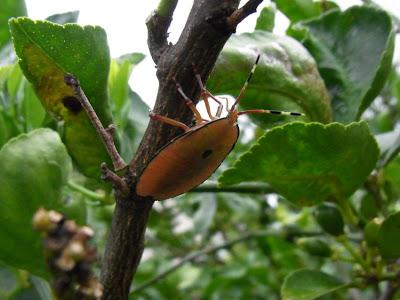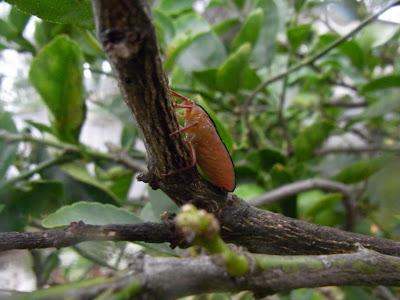Amid all the lovely surprises which keep me constantly fascinated here, the other side of the coin is that gardening is full of its annual and seasonal rituals, both good and bad. This morning we staged the Festival of the Stink Bugs, only slightly less dangerous than running with the bulls in Pamplona, and probably just as smelly.

Here's one of them now (well, if I had a camera with wide
angle lens hovering over the top of my lime tree, I could
have taken a shot with the caption "here's 12 of them now",
because that's what I discovered this morning, a lot of them.)
Sydney gardeners know this person well, the bronze orange
bug, also called the stink bug.

This bug sucks sap from plants, and it loves citrus in particular.
It goes through three stages of life, each marked by a different
colouring. When young it's green and hard to see, then now, in
its middle stage, it's bright orange and easy to spot. If it makes it
to adulthood it's hard to see once more, as it's black.
Wherever possible, I try to do everything the organic way in my garden, especially with food plants, but if that's not possible I then go for the least bad option. Most of the time I never reach into the 'least bad' bin of ideas, but for bronze orange bugs I do. Here's why...
One organic control for these pests is to physically knock them off the tree and drop them into a bucket of very hot water. That, my friends, is easier said than done! My lime tree is spiny, so it's not a great venue for bug whacking with a stick. And a precision bug whacker is needed to get them all. In many cases they just fall further down the tree and understandably try to hide. Getting up close to these bugs is also hazardous: they squirt an evil smelling spray when attacked (hence the name 'stink bug') and doing combat with them requires goggles and protective clothing, so the citrus spines don't make you look like an overly keen Easter crucifixion re-enactor. I have tried this 'knock them off' method but sorry, never again.
Another commonly mentioned organic control is even more impractical than precision whacking. It's suggested you use a vacuum cleaner to suck the little suckers off the tree. Oh great! Even if it works (and I have my doubts... have they thought through the practicalities of outdoor vacuuming of spiny trees, really??) your vacuum cleaner ends up smelling like a high school chemistry lab disaster. Sorry, not my Dyson!
And so, alas, it's off to the 'least bad' bin for a solution. And it's not so bad, either. Pyrethrum spray does the trick. This is the spray made from chemicals which naturally occur in certain daisy-family flowers. I just zap the individual bugs with it, not the whole tree. Even if you sprayed the whole tree (which would be a seriously dumb thing for a backyard gardener with one tree to do) the 'withholding period' with pyrethrum is just one day. In zapping a dozen or so bugs I reckon I sprayed about 2% of the tree, max.
And pyrethrum works. Some stink bugs succumb quickly to it, others take a few minutes to drop off the peg.
And so the moral of this story is this: if you have a backyard citrus tree in Australia, go outside and check it for bronze orange bugs now. October-November is the peak season for them. I'll leave the business of what you do next up to you.
